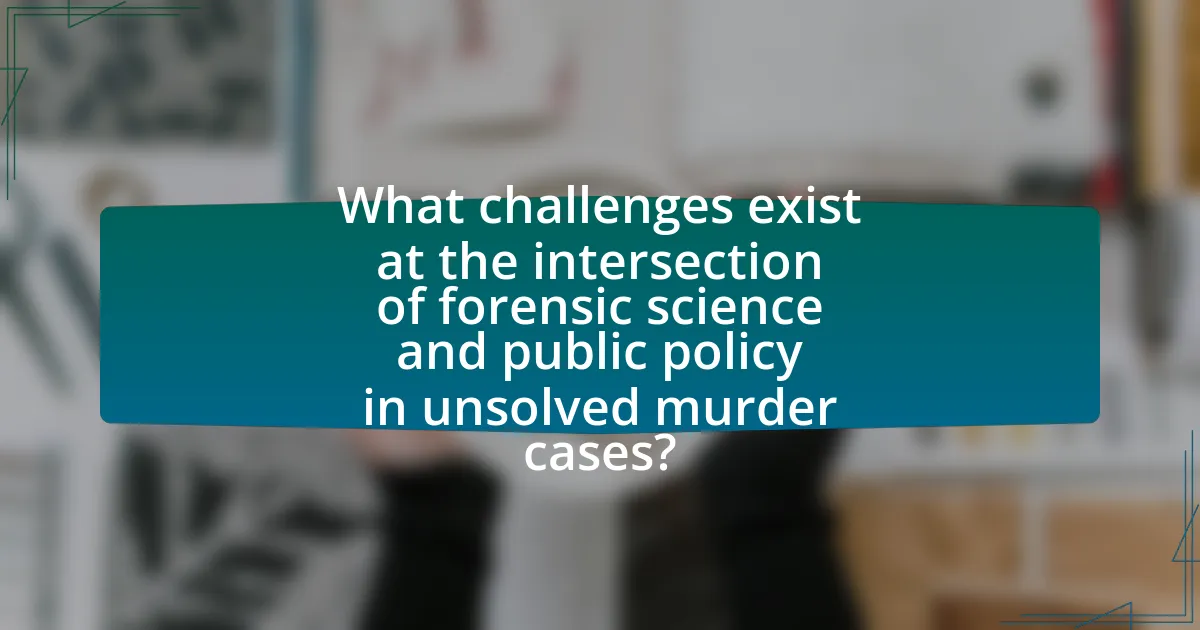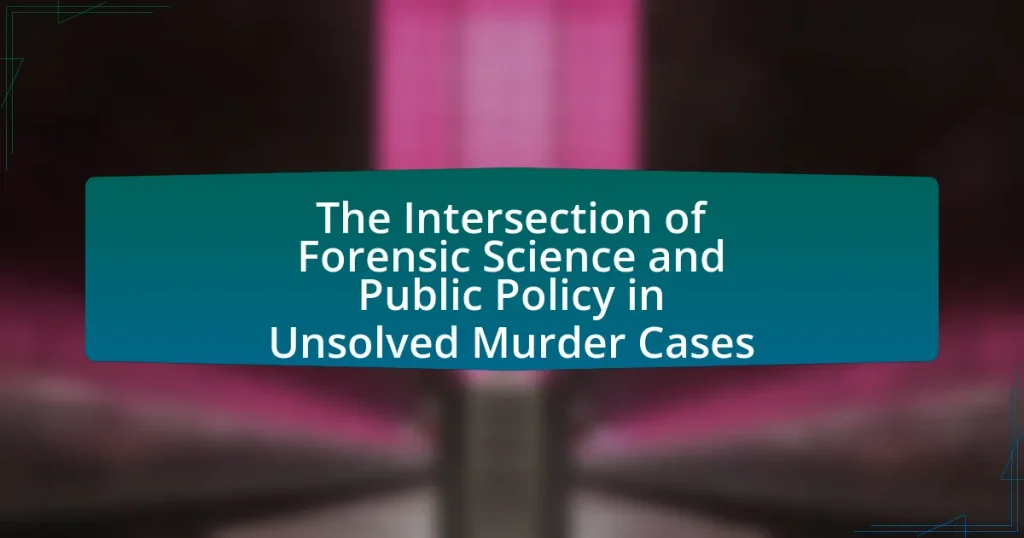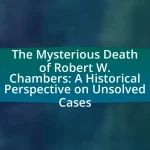The article examines the critical intersection of forensic science and public policy in addressing unsolved murder cases. It highlights how advancements in forensic techniques, particularly DNA analysis, influence legislative decisions and resource allocation within law enforcement. The discussion includes the role of forensic evidence in shaping public policy, the challenges faced by forensic scientists, and the impact of unsolved cases on community trust in law enforcement. Additionally, it explores the importance of funding, collaboration, and community engagement in enhancing forensic capabilities and improving investigative outcomes. The article underscores the need for effective policies that integrate scientific advancements to resolve cold cases and restore public confidence in the justice system.

What is the Intersection of Forensic Science and Public Policy in Unsolved Murder Cases?
The intersection of forensic science and public policy in unsolved murder cases involves the application of scientific methods to gather evidence that informs legislative and law enforcement practices. Forensic science provides critical data that can lead to the resolution of cold cases, influencing public policy decisions regarding resource allocation, investigative techniques, and legal frameworks. For instance, advancements in DNA analysis have prompted policy changes that allow for the re-examination of old evidence, thereby increasing the likelihood of solving previously unsolved cases. This relationship underscores the importance of integrating scientific advancements into public policy to enhance the effectiveness of criminal justice systems.
How do forensic science and public policy interact in the context of unsolved murder cases?
Forensic science and public policy interact significantly in the context of unsolved murder cases by influencing investigative practices and resource allocation. Forensic science provides critical evidence that can lead to solving cases, while public policy determines how resources are allocated for forensic investigations, including funding for laboratories and training for law enforcement. For example, the implementation of the DNA Identification Act of 1994 in the United States facilitated the use of DNA evidence in solving cold cases, demonstrating how policy can enhance forensic capabilities. Additionally, public policy can promote the establishment of databases that aid in linking unsolved cases, thereby improving the chances of resolution through scientific advancements.
What role does forensic evidence play in shaping public policy related to unsolved murders?
Forensic evidence plays a critical role in shaping public policy related to unsolved murders by providing scientific data that can influence legislative decisions and resource allocation. Policymakers utilize forensic advancements, such as DNA analysis and fingerprint technology, to develop laws that enhance investigative processes and improve the resolution rates of cold cases. For instance, the introduction of the DNA Identification Act in 1994 in the United States was driven by the need to utilize DNA evidence more effectively in solving unsolved murders, leading to increased funding for forensic laboratories and the establishment of national databases. This demonstrates how forensic evidence not only informs policy but also drives systemic changes aimed at addressing unsolved murder cases.
How can public policy influence the application of forensic science in investigations?
Public policy can significantly influence the application of forensic science in investigations by establishing standards, funding, and regulations that govern forensic practices. For instance, policies that mandate the use of DNA evidence in criminal cases can lead to more rigorous collection and analysis protocols, thereby enhancing the reliability of forensic results. Additionally, public funding for forensic laboratories can improve technological advancements and training for forensic professionals, as seen in the increased accuracy of forensic techniques following legislative support for laboratory upgrades. Furthermore, policies that promote transparency and accountability in forensic practices can help ensure that evidence is handled properly, reducing the risk of contamination or misinterpretation.
Why are unsolved murder cases significant in the realm of forensic science and public policy?
Unsolved murder cases are significant in forensic science and public policy because they highlight gaps in investigative techniques and the need for improved methodologies. These cases often reveal limitations in current forensic technologies, prompting advancements in DNA analysis, digital forensics, and investigative practices. For instance, the use of familial DNA has emerged from the need to solve cold cases, demonstrating how unsolved murders can drive innovation in forensic science. Additionally, they impact public policy by influencing resource allocation for law enforcement and shaping legislative measures aimed at enhancing crime-solving capabilities. The unresolved nature of these cases can lead to public outcry for justice, prompting policymakers to prioritize funding for forensic research and training.
What impact do unsolved murder cases have on community trust in law enforcement?
Unsolved murder cases significantly erode community trust in law enforcement. When law enforcement fails to solve murders, it creates a perception of ineffectiveness and lack of accountability, leading to diminished confidence among community members. Research indicates that communities with high rates of unsolved homicides often experience increased fear and skepticism towards police, as residents may feel that their safety is not prioritized. For example, a study published in the Journal of Criminal Justice found that neighborhoods with higher unsolved murder rates reported lower levels of trust in police and a belief that law enforcement is not responsive to their needs. This decline in trust can hinder cooperation between the community and law enforcement, making it more challenging to solve future crimes.
How do unsolved cases affect the allocation of resources in forensic science?
Unsolved cases significantly impact the allocation of resources in forensic science by diverting funding and personnel towards cold case investigations rather than new cases. Law enforcement agencies often prioritize unsolved cases to seek justice for victims and their families, which can lead to a reallocation of forensic resources such as DNA testing, expert consultations, and investigative manpower. For instance, the FBI’s Cold Case Initiative emphasizes the importance of solving historical cases, resulting in increased funding and resources directed towards these investigations. This focus can strain resources available for current cases, potentially delaying timely forensic analysis and response in ongoing investigations.

What challenges exist at the intersection of forensic science and public policy in unsolved murder cases?
Challenges at the intersection of forensic science and public policy in unsolved murder cases include issues of funding, the reliability of forensic techniques, and the integration of scientific evidence into legal frameworks. Limited financial resources often hinder the advancement and application of forensic technologies, which can delay investigations and the resolution of cases. Additionally, the reliability of certain forensic methods, such as bite mark analysis or hair comparison, has been questioned, leading to potential misinterpretations in court. Furthermore, public policy may not adequately address the need for standardized protocols in forensic science, resulting in inconsistencies across jurisdictions. These challenges can ultimately impede justice for victims and their families.
What are the common obstacles faced by forensic scientists in unsolved murder investigations?
Forensic scientists face several common obstacles in unsolved murder investigations, including limited physical evidence, contamination of crime scenes, and inadequate funding for forensic analysis. Limited physical evidence often results from time lapses between the crime and investigation, which can lead to degradation or loss of crucial materials. Contamination of crime scenes can occur due to improper handling or access by unauthorized individuals, compromising the integrity of evidence. Additionally, inadequate funding restricts the availability of advanced forensic technologies and personnel, hindering thorough investigations. These challenges collectively impede the ability of forensic scientists to solve cases effectively.
How do funding limitations affect forensic science capabilities in solving cold cases?
Funding limitations significantly hinder forensic science capabilities in solving cold cases by restricting access to advanced technologies and skilled personnel. Forensic laboratories often face budget constraints that limit their ability to conduct comprehensive analyses, such as DNA testing, toxicology, and ballistics examinations. According to a 2020 report by the National Institute of Justice, many forensic labs operate with outdated equipment and insufficient staffing, which delays case processing and reduces the likelihood of solving cold cases. Additionally, inadequate funding can lead to prioritization of current cases over cold cases, further prolonging the resolution of unsolved crimes.
What legal and ethical dilemmas arise in the use of forensic evidence for unsolved cases?
The use of forensic evidence in unsolved cases presents significant legal and ethical dilemmas, primarily concerning the reliability of evidence and the potential for wrongful convictions. Legal dilemmas arise from the admissibility of forensic evidence in court, as standards for evidence can vary, leading to challenges in its interpretation and application. Ethical dilemmas include the risk of prioritizing forensic evidence over other investigative methods, which may lead to tunnel vision and neglect of alternative leads. Furthermore, the potential for misuse of forensic technology, such as DNA databases, raises concerns about privacy and consent, particularly when individuals are implicated without sufficient evidence. These dilemmas highlight the need for stringent protocols and ethical guidelines to ensure that forensic evidence is used responsibly and justly in the pursuit of justice.
How does public policy address the challenges of unsolved murder cases?
Public policy addresses the challenges of unsolved murder cases through the implementation of strategic initiatives aimed at improving investigative processes and resource allocation. For instance, policies may promote the use of advanced forensic technologies, such as DNA analysis and digital forensics, which have been shown to significantly enhance the resolution rates of cold cases. According to the National Institute of Justice, jurisdictions that have adopted comprehensive cold case review policies have seen a 30% increase in case resolutions. Additionally, public policy can facilitate inter-agency collaboration, allowing law enforcement agencies to share information and resources more effectively, thereby increasing the likelihood of solving unsolved murders.
What legislative measures have been proposed to improve forensic science in cold cases?
Legislative measures proposed to improve forensic science in cold cases include the establishment of dedicated funding for forensic laboratories, the implementation of standardized protocols for evidence collection and analysis, and the promotion of training programs for law enforcement and forensic professionals. For instance, the Justice for Cold Cases Act, introduced in Congress, aims to allocate federal grants to state and local law enforcement agencies specifically for the purpose of enhancing forensic capabilities in unsolved cases. Additionally, the National Institute of Standards and Technology has recommended the adoption of best practices and quality assurance measures to ensure the reliability of forensic evidence. These initiatives are designed to address the backlog of cold cases and improve the overall effectiveness of forensic science in solving crimes.
How can public awareness campaigns influence policy changes regarding unsolved murders?
Public awareness campaigns can significantly influence policy changes regarding unsolved murders by mobilizing community support and drawing attention to the issue, which can lead to increased funding and legislative action. For instance, campaigns that highlight the prevalence of unsolved cases can pressure lawmakers to allocate resources for cold case units or forensic advancements. A notable example is the “Cold Case Initiative” in the United States, which emerged from public advocacy and resulted in the establishment of dedicated task forces and funding for forensic technology, ultimately solving numerous previously unsolved cases. This demonstrates that sustained public engagement can create a political climate conducive to reform and resource allocation in the realm of unsolved murders.

What are the future implications of the intersection of forensic science and public policy in unsolved murder cases?
The future implications of the intersection of forensic science and public policy in unsolved murder cases include enhanced investigative techniques, improved resource allocation, and increased public trust in law enforcement. As forensic science advances, techniques such as DNA analysis and digital forensics will become more sophisticated, allowing for the resolution of cold cases that were previously deemed unsolvable. Public policy can facilitate the integration of these technologies into law enforcement practices, ensuring that agencies have the necessary funding and training to utilize them effectively. Furthermore, transparent policies that prioritize accountability and community engagement can foster public trust, encouraging cooperation in investigations and potentially leading to new leads in unsolved cases. Historical examples, such as the use of DNA evidence in the exoneration of wrongfully convicted individuals, demonstrate the potential for forensic advancements to reshape public perceptions and policies surrounding criminal justice.
How might advancements in forensic technology impact public policy in the future?
Advancements in forensic technology are likely to significantly influence public policy by enhancing the accuracy and reliability of criminal investigations. As techniques such as DNA analysis, digital forensics, and advanced imaging become more sophisticated, they can lead to more effective law enforcement practices and improved judicial outcomes. For instance, the introduction of rapid DNA testing has already prompted policy discussions regarding the expedited processing of evidence, which can reduce wrongful convictions and increase public trust in the justice system. Furthermore, as forensic technologies evolve, they may necessitate updates to legal standards and protocols, ensuring that policies reflect the capabilities of modern science. This alignment can foster a more equitable legal framework, ultimately shaping how law enforcement agencies operate and how justice is administered.
What emerging forensic techniques could change the landscape of unsolved murder investigations?
Emerging forensic techniques such as advanced DNA analysis, forensic genealogy, and digital forensics have the potential to significantly change the landscape of unsolved murder investigations. Advanced DNA analysis, including next-generation sequencing, allows for the examination of degraded or limited biological samples, increasing the likelihood of obtaining usable genetic information. Forensic genealogy utilizes public DNA databases to trace familial connections, which has successfully solved cold cases by identifying suspects through their relatives. Digital forensics, encompassing the recovery and analysis of electronic data, can uncover critical evidence from devices like smartphones and computers, providing leads that were previously inaccessible. These techniques have already demonstrated effectiveness in high-profile cases, illustrating their transformative impact on solving unsolved murders.
How can policymakers ensure that forensic advancements are accessible to all jurisdictions?
Policymakers can ensure that forensic advancements are accessible to all jurisdictions by implementing standardized funding mechanisms and collaborative frameworks. Standardized funding can provide equitable resources for forensic technology and training across various jurisdictions, addressing disparities in access. Collaborative frameworks, such as partnerships between state and federal agencies, can facilitate knowledge sharing and resource allocation, ensuring that even smaller or underfunded jurisdictions benefit from the latest forensic advancements. For instance, the National Institute of Justice has programs that support forensic science initiatives, demonstrating the effectiveness of federal support in enhancing local capabilities.
What best practices can be implemented to enhance the intersection of forensic science and public policy?
To enhance the intersection of forensic science and public policy, implementing standardized protocols for evidence collection and analysis is essential. These protocols ensure consistency and reliability in forensic practices, which can lead to more accurate outcomes in investigations. For instance, the National Academy of Sciences report in 2009 emphasized the need for standardized practices to improve the credibility of forensic evidence in court. Additionally, fostering collaboration between forensic scientists and policymakers can facilitate the development of laws that support the use of advanced forensic technologies, such as DNA analysis, which has been shown to significantly aid in solving cold cases. Furthermore, ongoing training and education for law enforcement and forensic professionals on the latest scientific advancements can enhance the effectiveness of forensic applications in public policy.
How can collaboration between forensic scientists and policymakers be improved?
Collaboration between forensic scientists and policymakers can be improved through regular interdisciplinary meetings and joint training programs. These initiatives foster mutual understanding of each group’s challenges and objectives, enabling more effective communication and collaboration. For instance, the National Institute of Justice emphasizes the importance of integrating forensic science into policy discussions to ensure that scientific advancements inform legislative decisions. By establishing formal channels for ongoing dialogue, both parties can align their goals, share data, and develop policies that enhance the effectiveness of forensic science in solving unsolved murder cases.
What role does community engagement play in shaping effective policies for unsolved murder cases?
Community engagement plays a crucial role in shaping effective policies for unsolved murder cases by fostering collaboration between law enforcement and the community, which enhances trust and information sharing. Engaged communities can provide vital leads and insights that may not be accessible through traditional investigative methods, as evidenced by studies showing that community tips significantly contribute to solving cases. For instance, a report from the Bureau of Justice Assistance highlights that community involvement in crime prevention initiatives leads to a 20% increase in case resolution rates. This collaborative approach not only aids in gathering information but also ensures that policies reflect the community’s needs and concerns, ultimately leading to more effective crime-solving strategies.


